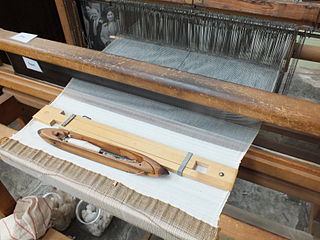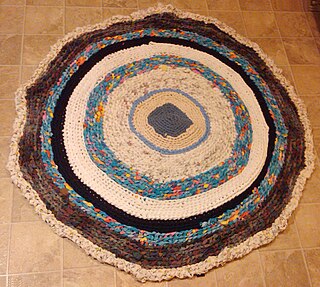A clootie is Scots for a rag or cloth. Clootie may refer to
- Clootie dumpling, a spiced suet fruit pudding boiled in a cloth
- Clootie well, a sacred well where strips of cloth are left for healing
- Clootie rug, a rag rug
A clootie is Scots for a rag or cloth. Clootie may refer to

A rug is a piece of cloth, similar to a carpet, but it does not span the width of a room and is not attached to the floor. It is generally used as a floor covering, or as a decorative feature.

A carpet is a textile floor covering typically consisting of an upper layer of pile attached to a backing. The pile was traditionally made from wool, but since the 20th century synthetic fibers such as polypropylene, nylon, or polyester have often been used, as these fibers are less expensive than wool. The pile usually consists of twisted tufts that are typically heat-treated to maintain their structure. The term carpet is often used in a similar context to the term rug, but rugs are typically considered to be smaller than a room and not attached to the floor.
Rag, rags, RAG or The Rag may refer to:

Culloden is the name of a village three miles east of Inverness, Scotland and the surrounding area. 3 mi (5 km) east of the village is Drumossie Moor, site of the Battle of Culloden.

Knot density is a traditional measure for quality of handmade or knotted pile carpets. It refers to the number of knots, or knot count, per unit of surface area - typically either per square inch (kpsi) or per square centimeter (kpsc), but also per decimeter or meter. Number of knots per unit area is directly proportional to the quality of carpet. Density may vary from 25 to 1,000 knots per square inch or higher, where ≤80 kpsi is poor quality, 120 to 330 kpsi is medium to good, and ≥330 kpsi is very good quality. The inverse, knot ratio, is also used to compare characteristics. Knot density = warp×weft while knot ratio = warp/weft. For comparison: 100,000/square meter = 1,000/square decimeter = 65/square inch = 179/gereh.

A durag is a close-fitting cloth tied around the top of the head to protect the hair; similarly a wave cap is a close-fitting cap for the same purpose. Durags may be worn to accelerate the development of long curly/kinky hair, waves or locks in the hair; to maintain natural oils in hair ; to stop hair breakage; to manage hair in general; or to keep hair, wave patterns and braids from shifting while sleeping. Durags are also worn as an identity-making fashion choice, popular in Black culture and African-American culture.

Rug hooking is both an art and a craft where rugs are made by pulling loops of yarn or fabric through a stiff woven base such as burlap, linen, or rug warp. The loops are pulled through the backing material by using a crochet-type hook mounted in a handle for leverage. In contrast latch-hooking uses a hinged hook to form a knotted pile from short, pre-cut pieces of yarn.
Doo rag may refer to:

A clootie well is a holy well, almost always with a tree growing beside it, where small strips of cloth or ribbons are left as part of a healing ritual, usually by tying them to branches of the tree. Clootie wells are places of pilgrimage usually found in Celtic areas. It is believed the tradition comes from the ancient custom of leaving votive offerings in water. In Scots, a clootie or cloot is a strip of cloth or rag.

A clootie dumpling is a traditional Scottish pudding made with flour, breadcrumbs, dried fruit, suet, sugar and spices with some milk to bind it. Ingredients are mixed well into a dough, then wrapped up in a floured cloth, placed in a large pan of boiling water and simmered for a few hours before being lifted out and dried near the fire or in an oven. Recipes vary from region to region.

Rag pudding is a savoury dish consisting of minced meat and onions wrapped in a suet pastry, which is then cooked in a cheesecloth. Invented in Oldham, the dish is also popular in Bury and Rochdale, and is eaten across the Lancashire area. Rag pudding pre-dates ceramic basins and plastic boiling bags in cookery, and so the cotton or muslin rag cloths common in Oldham were used in the dish's preparation during the 19th century. Rag pudding is similar in composition and preparation to steak and kidney pudding, and may be purchased from traditional local butcher's shops in Lancashire.

A wish tree is a tree, usually distinguished by species, location or appearance, which is used as an object of wishes and offerings. Such trees are identified as possessing a special religious or spiritual value. Postulants make votive offerings in hopes of having a wish granted, or a prayer answered, from a nature spirit, saint or goddess, depending on the local tradition.
Cotton paper, also known as rag paper or rag stock paper, is made using cotton linters or cotton from used cloth (rags) as the primary material. Prior to the mid-19th century, cotton paper was the main form of paper produced, with pulp paper replacing cotton paper as the main paper material during the 19th century. Although pulp paper was cheaper to produce, its quality and durability is significantly lower. Although pulp-paper quality improved significantly over the 20th century, cotton paper continues to be more durable, and consequently important documents are often printed on cotton paper. Different grades of cotton paper can be produced.
Pudding is a dessert or a savory dish.

A temple is an adjustable stretcher used on a loom to maintain the width and improve the edges of the woven fabric.

A pudding cloth is a culinary utensil similar to a cheesecloth or muslin. It is a reusable alternative to cooking in skins made of animal intestines and became popular in England in the seventeenth century for boiling a wide range of puddings.
Glad Rags was an Irish Thoroughbred racehorse.

The Lady's Well is a natural spring surmounted by a large cross that stands beside the Stra Burn Ford (NS254630) near Auchmannoch House in the Parish of Sorn, East Ayrshire, Scotland. It is associated with the Virgin Mary as a curative well, a Wishing Well and also a Clootie well, additionally Mary Queen of Scots is said to have once watered her horse here. A large red sandstone cross was erected here at an unrecorded date. The well is also said to have acquired its name through "..one of the ladies of Auchmannoch family drinking water exclusively from here."

A rag rug is a rug or mat made from rags. Small pieces of recycled fabric are either hooked into or poked through a hessian backing, or else the strips are braided or plaited together to make a mat. Other names for this kind of rug are derived from the material or technique.
A catalogne is a type of woven French-Canadian rag rug, also sometimes used as a blanket, with origins in France, possibly of Norman influence, and later developed in Quebec. Named for one Sieur de Catalan, who lived in the 17th century, the catalogne gained popularity in the New World in the early to mid-19th century. Initially prevalent in Quebec where new cloth was limited, catalogne weaving was also a tradition found in Madawaska County, New Brunswick, and some parts of New England such as Aroostook County, Maine, and later appeared in Ontario. Catalognes are typically woven with a cotton warp and a combination of rags and fragments of clothing and tapestries, cut into strips and spun before being woven into the warp. These used materials were generally made of cotton or wool, textiles available at the time, and were traditionally of striped patterns.